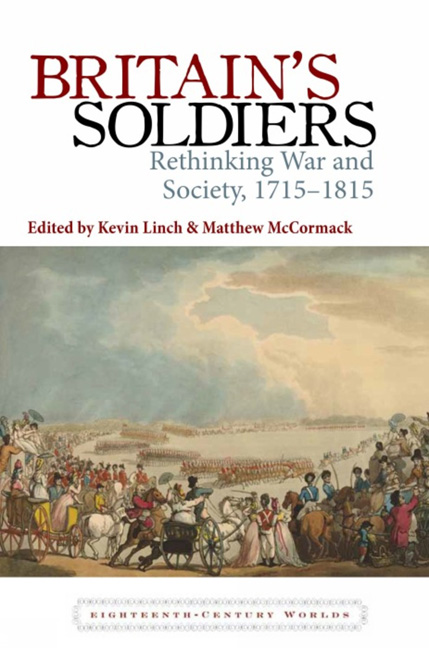Book contents
- Frontmatter
- Contents
- List of tables and figures
- Acknowledgements
- Notes on the contributors
- Introduction
- Part 1 Nationhood
- Part 2 Hierarchy
- Part 3 Discipline
- Part 4 Gender
- 7 Conflicts of Conduct: British Masculinity and Military Painting in the Wake of the Siege of Gibraltar
- 8 Scarlet Fever: Female Enthusiasm for Men in Uniform, 1780–1815
- Part 5 Soldiers in Society
- Index
8 - Scarlet Fever: Female Enthusiasm for Men in Uniform, 1780–1815
from Part 4 - Gender
- Frontmatter
- Contents
- List of tables and figures
- Acknowledgements
- Notes on the contributors
- Introduction
- Part 1 Nationhood
- Part 2 Hierarchy
- Part 3 Discipline
- Part 4 Gender
- 7 Conflicts of Conduct: British Masculinity and Military Painting in the Wake of the Siege of Gibraltar
- 8 Scarlet Fever: Female Enthusiasm for Men in Uniform, 1780–1815
- Part 5 Soldiers in Society
- Index
Summary
IN 1804 Sporting Magazine carried a letter to the editor alerting readers to a ‘dangerous disorder prevalent in wartime’, principally afflicting women. The main symptoms of the malady were listed as an excessive regard for clothing of a deep red hue, a remarkable attachment to military music, sighing, listlessness and an inattention to all topics and company unconnected with the military. The author cautioned that particular attention needed to be paid to sufferers when the disease was at its crisis because they became ‘uncommonly desirous of a jaunt in a post chaise, a passage through the back door or window, or a trip up or down a ladder’. The name of the condition, according to this wit, was scarlet fever. Unlike its pathological namesake, this variety of scarlet fever did not result in a rash, sore throat or raised temperature. Nevertheless, it was to be regarded as potentially just as dangerous since it caused women to swoon and throw caution to the wind at the sight of a military man turned out in his regimental finery. The contagion was also reported to be highly infectious and already spreading rampantly through boarding schools and families with young daughters. Indeed, since military men themselves seemed only too keen to encourage a full-blown epidemic to blossom, the author feared that evermore British women might soon succumb to the passions and follies aroused by scarlet fever.
This chapter turns to the military man as a focus of female admiration and considers what the discourse surrounding scarlet fever might reveal about Georgian society and the position of the soldier within it. On one hand, we might dismiss women's attraction to men in uniform as simply ‘natural’ and ahistorical – an attraction between the sexes being a constant across time and it therefore being unsurprising that a portion of it was directed towards military men, particularly since the warrior has repeatedly been valorised by various societies as the apotheosis of masculinity. Yet, as this chapter will explore, a study of the precise form that this association took and the attitudes and assumptions it exposed can provide us with a glimpse into several key contemporary debates and concerns.
- Type
- Chapter
- Information
- Britain's SoldiersRethinking War and Society, 1715–1815, pp. 155 - 180Publisher: Liverpool University PressPrint publication year: 2014

